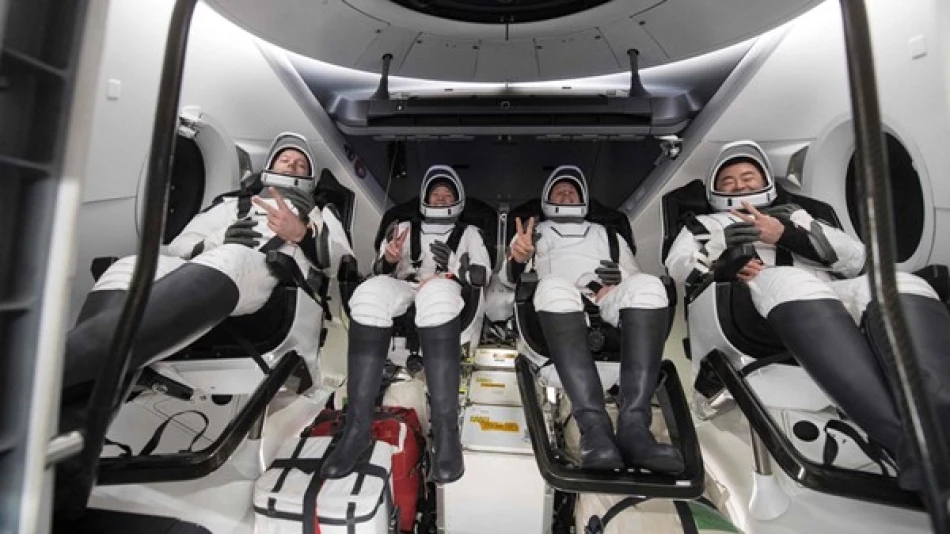
Intrepid Astronauts Depart International Space Station: A Captivating Cosmic Journey Ends
Crew-10 Astronauts Return to Earth After 146-Day Mission as Boeing Starliner Saga Reaches Closure
Four international astronauts from NASA's Crew-10 mission splashed down safely in the Pacific Ocean off California's coast Saturday morning, concluding a five-month rotation aboard the International Space Station that became intertwined with Boeing's troubled Starliner program. The mission's end also marked a symbolic closure as veteran astronaut Butch Wilmore announced his retirement from NASA after 25 years of service.
Routine Mission Becomes Part of Larger Space Program Narrative
The SpaceX Dragon capsule carrying American astronauts Nicole Ayers and Anne McClain, alongside Japanese astronaut Takuya Onishi and Russian cosmonaut Kirill Peskov, completed its 17.5-hour journey from the ISS at 11:33 AM EST Saturday. What began as a standard crew rotation mission on March 14 became noteworthy due to its connection to the Crew-9 mission and the extended stay of astronauts affected by Boeing's Starliner setbacks.
The Crew-10 team replaced the previous Crew-9 astronauts, including Butch Wilmore and Suni Williams, who had originally traveled to the station aboard Boeing's Starliner capsule. Technical issues with Starliner forced NASA to extend their mission significantly, highlighting the ongoing challenges facing Boeing's commercial crew program.
Scientific Returns and Research Achievements
During their 146-day mission, the four-person crew conducted over 200 scientific experiments in the unique microgravity environment of the ISS. NASA emphasized that the returning astronauts brought back "critical and sensitive research" that could only be performed in space, underscoring the continued scientific value of long-duration missions.
The research conducted during Crew-10's stay spans multiple disciplines, from materials science and biology to technology demonstrations that could benefit future deep space exploration missions. This scientific productivity demonstrates how routine crew rotations have become essential infrastructure for advancing space-based research.
End of an Era: Wilmore's Retirement Signals Generational Shift
Butch Wilmore's announcement of his retirement from NASA this week represents more than just one astronaut's career conclusion. His 25-year tenure, during which he flew on four different spacecraft and logged 464 days in space, spans the transition from Space Shuttle operations to the current commercial crew era.
Wilmore served as a key technical advisor for the Starliner program alongside Suni Williams, who continues her work with NASA's astronaut corps. His retirement comes at a pivotal moment as NASA increasingly relies on commercial partners like SpaceX for crew transportation, while Boeing works to resolve Starliner's technical challenges.
Commercial Crew Program's Mixed Success Record
The successful return of Crew-10 aboard SpaceX's Dragon capsule reinforces the company's dominant position in NASA's commercial crew program. Since resuming crewed launches from American soil in 2020, SpaceX has maintained a consistent track record of safe crew rotations, contrasting sharply with Boeing's ongoing struggles.
This mission's completion highlights the program's original vision of having multiple commercial providers, though Boeing's delays have left SpaceX as the primary option for crew transportation. The situation mirrors broader trends in the commercial space industry, where execution capability increasingly determines market leadership over traditional aerospace relationships.
Looking Forward: Implications for Future Missions
As NASA prepares for its Artemis lunar program and eventual Mars missions, the lessons learned from routine ISS operations like Crew-10 become increasingly valuable. The international cooperation demonstrated by this mission—with American, Japanese, and Russian crew members—provides a template for future deep space exploration efforts.
The scientific research returned by Crew-10 will likely influence mission planning for longer-duration flights beyond Earth orbit, where crew health and equipment reliability become even more critical factors for success.
Most Viewed News

 Layla Al Mansoori
Layla Al Mansoori






